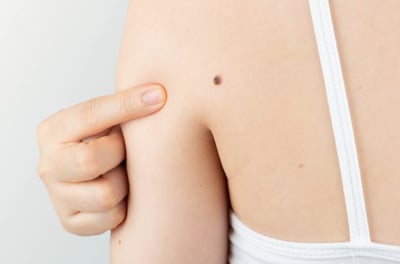
Skin cancer is the most common cancer in the United States, with 1 in 5 Americans developing it in their lifetime. Regular self-skin exams and a yearly skin cancer screening by your local dermatologist are crucial in finding cancer early.
What age should I start getting skin checks?
The rule of thumb is to start getting skin checks for skin cancer in your 20s. However, you should be checked sooner if you have a family history of skin cancer or have noticed a spot on your skin that has changed. Additionally, while rare, children can develop skin cancer, including pediatric melanoma. This is why being mindful of your skin or your child’s skin is extremely important.
What happens during a skin check?
A routine skin check is a simple 10-minute appointment where a dermatologist examines your body, looking for any areas of concern. It starts with changing into a hospital-style gowns. Before the skin check begins, your doctor will ask if you have any concern areas. Now is not the time to not be shy; point out any areas that you may have noticed changes in. Your dermatologist will examine each part of your skin and may use a special magnifying glass with a light—called a dermatoscope—to examine certain suspicious spots. If a suspicious lesion is identified, you may need a biopsy. A biopsy is a quick procedure that helps diagnose the condition. A local anesthetic is applied, and a small tissue sample is taken from the suspicious area. The sample is then sent to a pathology lab where results are determined. If the biopsy reveals skin cancer, the remainder of the growth will be removed at a later date.
Can I do an at-home skin check?
Yes! Skin checks should be done monthly, but never replace your annual skin check with a dermatologist. When looking over your skin monthly think about the ABCDEs of skin cancer:
- Asymmetry: Melanoma lesions are often irregular or not symmetrical in shape. A non-cancerous mole is typically symmetrical in shape. The two halves should roughly match if you draw a line through the middle of a mole.
- Border: Typically, a non-cancerous mole will have smooth, even borders. Melanoma lesions usually have irregular borders that are difficult to define.
- Color: A non-cancerous mole is commonly a single shade of brown or tan. The presence of more than one color or uneven distribution of color can be a warning sign of melanoma. Melanoma can occur in various colors, including brown, black, red, blue, or purple. These spots can be flat or raised and can bleed easily. Non-melanoma skin cancer, also known as basal and squamous cell carcinoma, typically appears as small, pearly, or pale bumps or dark red patches that can be raised, flat, or scaly in texture.
- Diameter: Non-cancerous moles are typically smaller than malignant ones. If its diameter is greater than a pencil eraser, it may be a sign that it is growing or changing. Larger moles that have been stable for an extended period of time are not typically cause for concern, though continued observation is recommended.
- Evolution: The evolution of a mole is the most critical factor to consider when performing a self-skin check. This is why monthly at-home checks are so necessary. If you know what is normal, you can easily tell if it has grown or evolved, over time.
Be Proactive
Early detection saves lives, and a simple, yearly in-office skin check with your local board-certified Forefront Dermatologist can truly mean the difference between life and death. Contact us today to schedule your annual skin check.





